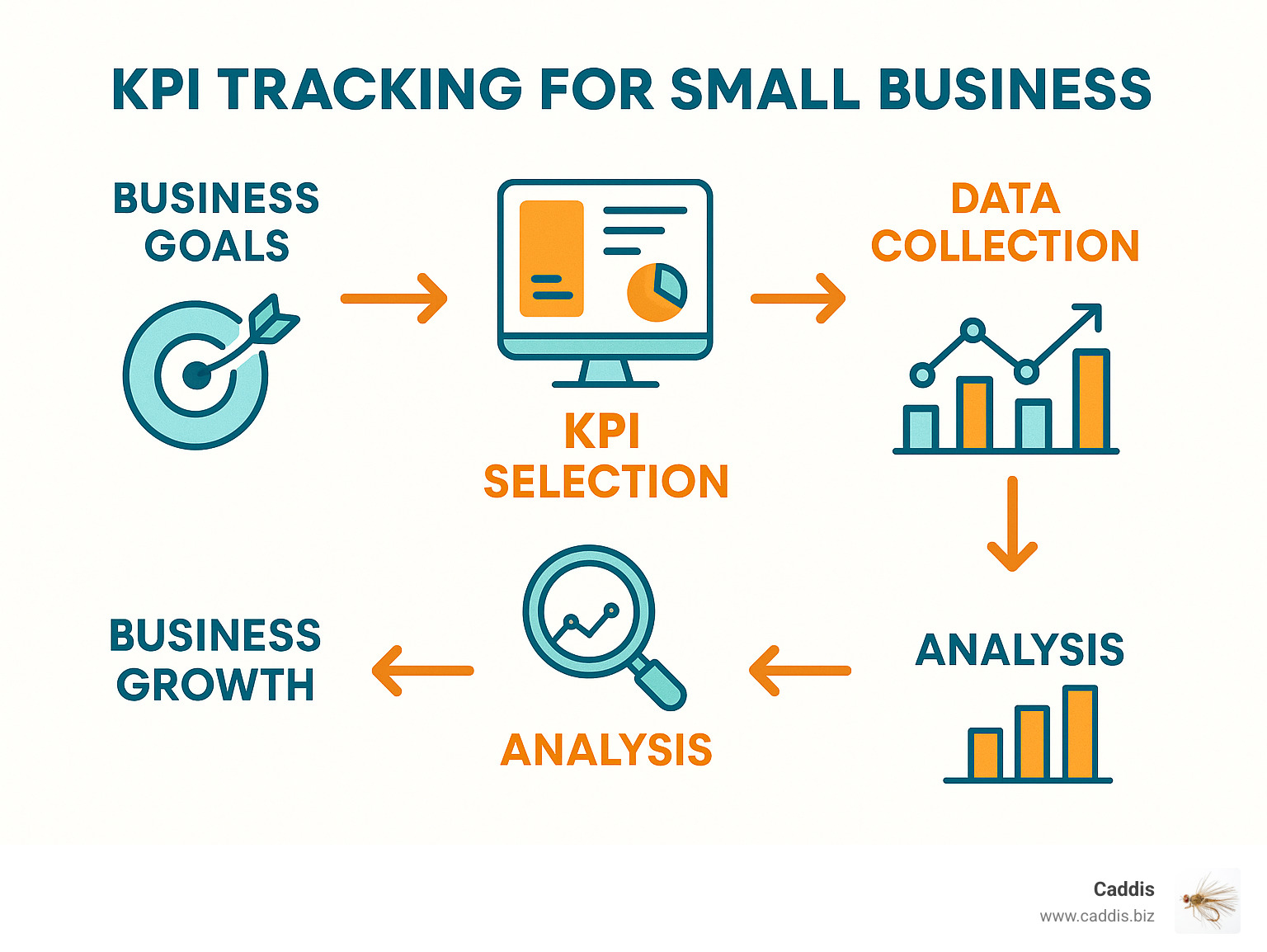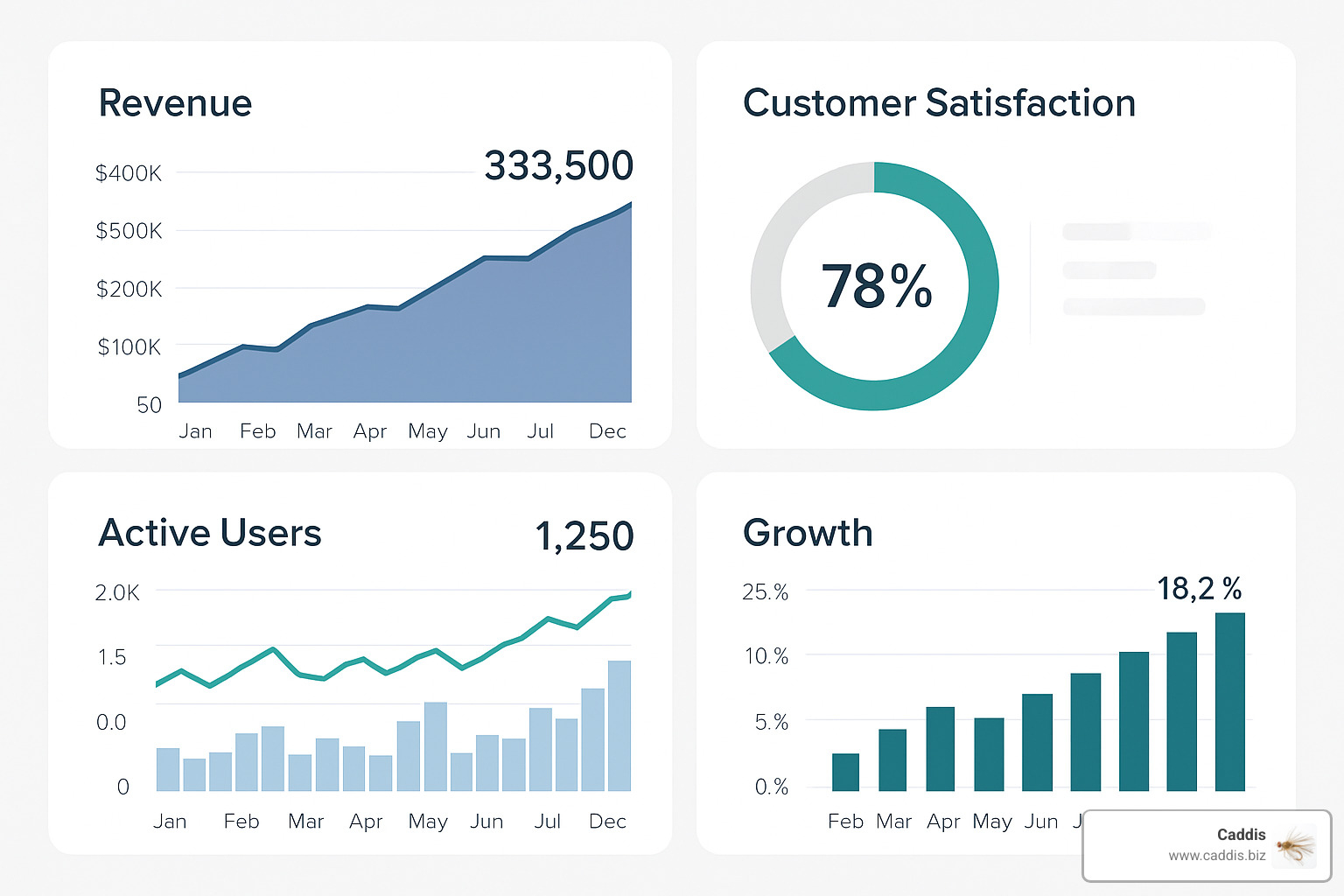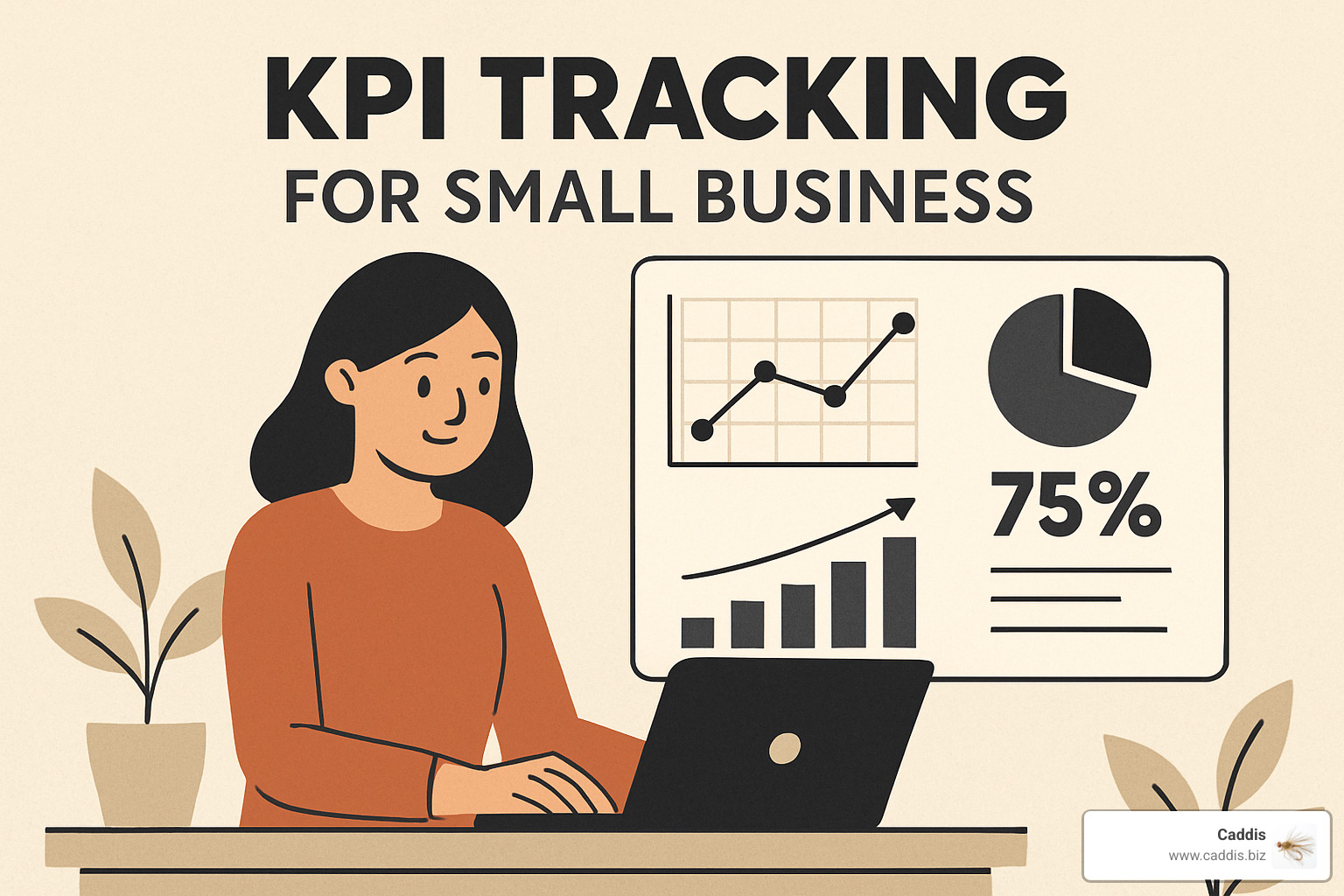Why KPI Tracking for Small Business is Critical for Survival
KPI tracking for small business isn’t just a nice-to-have – it’s your lifeline in today’s competitive market. According to the US Bureau of Labor Statistics, around 1 in 5 new businesses fail within a year, and half fail within 5 years. The difference between thriving and becoming another statistic? Data-driven decision making.
Here’s what you need to know about KPI tracking for small business:
- KPIs are measurable values that show how effectively your business achieves key objectives
- Track 5-10 key indicators to avoid information overload while maintaining clarity
- Focus on actionable metrics that directly impact your bottom line, not vanity metrics
- Review frequency varies – daily for operational KPIs, monthly/quarterly for strategic ones
- Leading indicators predict future performance while lagging indicators measure past results
Most small business owners rely on gut feelings and intuition, but that’s not enough anymore. Companies that monitor KPIs are much more likely to achieve profitable growth. Without clearly defined KPIs, you’re flying blind – missing opportunities, reducing profits, and decreasing competitiveness.
Think of KPIs as your business’s vital signs. Just like doctors use blood pressure and heart rate to assess health, you need specific metrics to gauge your business’s performance and potential.
This guide will walk you through everything you need to know about KPI tracking – from choosing the right metrics to implementing tracking systems that actually work for small businesses.
I’m Jeff Mount, founder of Caddis LLC, and I’ve spent years helping small businesses implement effective KPI tracking for small business growth and improved decision-making. My approach combines strategic thinking with practical tools that work in real-world scenarios, not just theory.

What Are KPIs and Why Are They Your Business’s Best Friend?
Let me start with a simple truth: Key Performance Indicators (KPIs) are your business’s best friend because they tell you exactly what’s happening when it matters most. Think of them as having a really honest friend who always tells you the truth about how you’re doing – even when it’s not what you want to hear.
Here’s something that trips up a lot of small business owners: not all metrics are KPIs, but all KPIs are metrics. It’s like the difference between collecting coins and collecting rare coins. You might track your website visitors (that’s a metric), but your KPI is how many of those visitors actually become paying customers. See the difference?
KPIs are quantifiable measures that show how effectively your business achieves its strategic objectives. They’re your business’s report card, but better – because you get to see your grades in real-time and actually do something about them.
The Strategic Power of KPIs
When you implement KPI tracking for small business, you’re essentially giving yourself superpowers. No, really – here’s what happens:
You get laser focus instead of feeling scattered. Instead of wondering if you should work on your website, your marketing, or your customer service, your KPIs tell you exactly where to spend your energy. It’s like having a GPS for your business decisions.
Everyone becomes accountable – including you. When you’re tracking specific numbers, there’s no hiding behind vague statements like “we’re doing pretty well.” Either your customer satisfaction score is 85% or it’s 65%. Either your profit margin is growing or it’s shrinking.
You spot problems before they become disasters. A declining customer satisfaction score warns you about potential churn before it shows up in your revenue. It’s like having a smoke detector instead of waiting for the fire.
Your team gets motivated by real progress. Nothing builds momentum like watching key metrics improve week after week. It turns abstract work into concrete wins.
Aligning KPIs with SMART Goals
For KPIs to actually work for your business, they need to tie directly to your goals. This is where the SMART goals framework becomes your secret weapon – goals that are Specific, Measurable, Achievable, Relevant, and Time-bound.
Let’s say you want to “increase sales” (who doesn’t?). That’s not a SMART goal – it’s just wishful thinking. But “increase monthly recurring revenue by 20% within the next quarter” – now that’s something you can actually track and achieve. It creates a clear KPI (monthly recurring revenue) with a specific target and timeline.
The magic happens when your KPIs become both measurement tools and strategic weapons. A detailed explanation on Key Performance Indicators shows that successful businesses don’t just track performance – they use KPIs to drive it forward.
As we discuss in our article on KPIs: The Hard Truth About Winning in Business, the businesses that win are those that accept data-driven decision making. Your KPIs become your early warning system when things go wrong, your celebration triggers when things go right, and your roadmap for continuous improvement.
The bottom line? KPIs turn guesswork into strategy. They transform “I think we’re doing well” into “I know exactly how we’re doing and what we need to do next.”
How to Choose the Right KPIs (Without Getting Overwhelmed)
Standing in front of dozens of possible metrics can feel like being in a candy store with only five dollars—everything looks great, but you can’t have it all. Use this three-step filter to pick wisely:
- Start with the goal. Your objectives dictate the metrics, not the other way around. Ask, “If this number moves, will it move my business forward?” If the answer’s no, it’s not a KPI.
- Limit yourself to 5–10 indicators. That range gives you a 360° view without causing dashboard fatigue. When everything is important, nothing is.
- Balance leading and lagging metrics. Leading indicators (sales calls made, website traffic) predict; lagging indicators (revenue, churn) confirm. Track a mix so you can steer and verify.
Different stages of business call for different KPIs:
- Start-ups: cash flow, customer acquisition count, break-even date.
- Established firms: customer lifetime value, employee productivity, process efficiency.
- Scaling companies: margin protection, market share, system capacity.
Finally, bring your team into the conversation. When employees help choose the numbers, they understand them, believe in them, and are far more likely to hit them.
15+ Essential KPIs Your Small Business Should Be Tracking

KPIs fall into three core categories. Think of them as a story: operations create happy customers, happy customers create revenue, and revenue funds future operations.
Financial KPIs (Can you keep the lights on?)
- Net Profit Margin – Percent of every dollar that ends up as profit. Aim as high as your industry allows; many service firms target 25%.
- Gross Profit Margin – Profit from core products before overhead. A quick warning signal if costs creep up.
- Operating Cash Flow – Real cash generated by operations. Paper profits don’t pay bills—cash does.
- Quick Ratio – (Cash + receivables) ÷ current liabilities. A 1.0 ratio means you can meet short-term obligations without selling inventory.
- Break-Even Point – Revenue needed each month to cover all costs. Crucial for pricing and sales targets.
Sales & Marketing KPIs (Are you growing efficiently?)
- Sales Revenue – Track the trend, not just the total. Consistent growth beats erratic spikes.
- Customer Acquisition Cost (CAC) – Total marketing & sales spend ÷ new customers. Retail averages about $10; tech often hundreds.
- Customer Lifetime Value (LTV) – Total revenue expected from a customer. Healthy businesses keep an LTV:CAC ratio near 3:1.
- Lead Conversion Rate – Leads that become customers. Segment by source to double-down on what works.
- Website Traffic Quality – Visitors who take the desired action (download, buy, book). Quality beats sheer volume.
- Social Media Engagement – Shares, comments, or clicks—not just likes.
Customer & Operational KPIs (Will customers stick around?)
- Customer Satisfaction (CSAT) – Survey score after purchase or service interaction. Higher CSAT usually means repeat business.
- Net Promoter Score (NPS) – Likelihood to recommend. Above 50 is excellent; the trend matters more than the absolute score.
- Customer Churn Rate – Customers lost ÷ total customers. Reducing churn is often cheaper than adding new customers.
- Employee Retention Rate – Happy staff create happy customers; aim for <15% annual turnover.
- On-Time Delivery – % of orders arriving as promised. Capgemini found 45% of consumers stop recommending brands after late delivery.
Use these lists as a starting menu, not a mandatory checklist. Pick the handful that move your biggest goals, track them relentlessly, and drop the rest.
The Ultimate Toolkit for KPI Tracking for Small Business

Good news: modern tools mean you can track KPIs on almost any budget. Start simple, upgrade later.
Dashboards vs. Reports
- Dashboards – Real-time, visual, actionable. Glance at them like you glance at your car’s speedometer.
- Reports – Historical, detailed, strategic. Review them in weekly or monthly meetings to spot trends.
Trying to use one in place of the other causes frustration—keep both in their lane.
Recommended Software (pick one, master it, then expand)
- HubSpot – Free tier, integrates marketing, sales and service data.
- Salesforce for small business – Powerful but requires more setup.
- Geckoboard – Beautiful plug-and-play dashboards that motivate teams.
- Google Looker Studio – Free, connects easily to Google products.
- Good old spreadsheets – Excel or Google Sheets still work for many companies starting out.
Avoid These Common Pitfalls
- Too many metrics – Stick to 5–10 per dashboard.
- Vanity numbers – If a metric can’t drive action, drop it.
- Bad data – One unreliable feed can make the whole system useless.
- No ownership – Assign every KPI to a specific person.
- Set-and-forget – Review your list quarterly; evolve with your business.
Start small, keep it accurate, and act on what you learn—otherwise even the best software is just expensive wall art.
Frequently Asked Questions about Small Business KPIs
Let’s address the most common questions we hear from small business owners about KPI tracking for small business. These answers will help you avoid common mistakes and set up a system that actually works.
How many KPIs should a small business track?
Here’s the truth: less is definitely more when it comes to KPI tracking. Most successful small businesses focus on 5-10 key indicators per dashboard or business goal.
Think of it this way – if everything is important, nothing is important. When you try to track 20 or 30 different metrics, you end up with analysis paralysis instead of actionable insights. Your brain can only process so much information at once.
Start small and smart. Pick 3-5 KPIs that directly connect to your most critical business objective. Maybe that’s monthly revenue, customer acquisition cost, and customer satisfaction score. Get comfortable tracking these metrics, understanding what they mean, and acting on the insights they provide.
Once you’ve mastered your core KPIs, you can gradually add others. But remember – every KPI you track should drive specific actions. If you can’t do something about the data, don’t waste time collecting it.
What is the difference between a leading and a lagging KPI?
This is one of the most important concepts in KPI tracking for small business, and it’s simpler than it sounds.
Leading indicators are like the steering wheel of your car – they help you control where you’re going. These metrics predict future performance and measure the activities that drive results. When you make more sales calls, you’re likely to close more deals next month. When customer satisfaction scores improve, churn rates typically drop later.
Lagging indicators are like your car’s odometer – they tell you where you’ve been. These metrics measure results after they’ve already happened. Your quarterly revenue is a lagging indicator. You can’t change last quarter’s numbers, but you can learn from them.
The magic happens when you track both types. Leading indicators like sales calls made or website traffic growth help you steer toward better results. Lagging indicators like quarterly revenue or customer churn rate confirm whether your efforts worked.
A balanced KPI system gives you both predictive power and performance validation. You need both to steer your business effectively.
How often should my business review its KPIs?
The review frequency depends on what you’re measuring and how quickly you need to act on changes. Here’s how we recommend thinking about it:
Daily reviews work best for operational KPIs that require immediate attention. Your daily sales numbers, customer service response times, and inventory levels need constant monitoring. These metrics can change quickly and often require same-day action.
Weekly reviews make sense for tactical KPIs that inform short-term decisions. Lead generation metrics, social media engagement, and employee productivity measures typically show meaningful patterns over a week. This gives you enough data to spot trends without getting lost in daily fluctuations.
Monthly reviews are perfect for strategic KPIs that guide medium-term planning. Customer acquisition costs, employee retention rates, and gross profit margins usually need a full month of data to be meaningful. Monthly reviews let you see patterns and make strategic adjustments.
Quarterly reviews work well for high-level KPIs that inform long-term strategy. Net profit margins, market share, and return on investment typically require longer time periods to show significant changes. Quarterly reviews align with most business planning cycles.
The most important thing? Consistency beats perfection. It’s better to review your KPIs regularly on a simple schedule than to have elaborate review processes that you skip when things get busy. Pick a rhythm that works for your business and stick to it.
Sporadic attention to KPIs defeats their entire purpose. They’re only valuable when you use them to make better decisions consistently.
Conclusion
Think of KPI tracking for small business as your GPS for navigating the complex world of entrepreneurship. Just like you wouldn’t drive cross-country without directions, you shouldn’t run your business without clear metrics to guide your decisions.
The statistics we shared earlier aren’t just numbers – they represent real businesses and real dreams. The difference between thriving and becoming another casualty? Companies that accept data-driven decision making through proper KPI tracking are far more likely to achieve sustainable, profitable growth.
As we discuss in Your Company Must Grow Right Now!, growth isn’t a luxury in today’s market – it’s survival. The businesses that monitor their vital signs through KPIs spot opportunities early, catch problems before they become crises, and make decisions based on facts rather than feelings.
Your change from gut-feeling management to data-driven leadership starts with a single step. Don’t try to boil the ocean on day one. Start with 5-10 KPIs that directly align with your most important business goals. Balance your leading indicators (what’s coming) with lagging indicators (what happened). Choose tools that fit your comfort level and budget – even a simple spreadsheet beats flying blind.
The magic happens when you commit to regular review and actually act on what the data tells you. Your KPIs become your early warning system, your celebration triggers, and your roadmap for continuous improvement. They empower you to make confident decisions because you know exactly where you stand and where you’re heading.
At Caddis, we’ve witnessed the change that happens when small businesses and financial advisors implement robust KPI tracking systems. Our approach combines strategic thinking with practical tools that work in real-world scenarios. We help businesses move beyond vanity metrics to focus on the numbers that truly drive growth and increase business valuation.
Your business’s future is being written by the decisions you make today. KPIs give you the clarity and confidence to write that story based on data, not guesswork. Every successful business started somewhere – why not start with the competitive advantage that comes from truly understanding your performance?
Ready to transform your business with professional KPI implementation and strategic growth planning? Learn how a Fractional Chief Revenue Officer can help you implement and track the right KPIs for growth. Let’s work together to turn your business data into your secret weapon for sustainable success.


